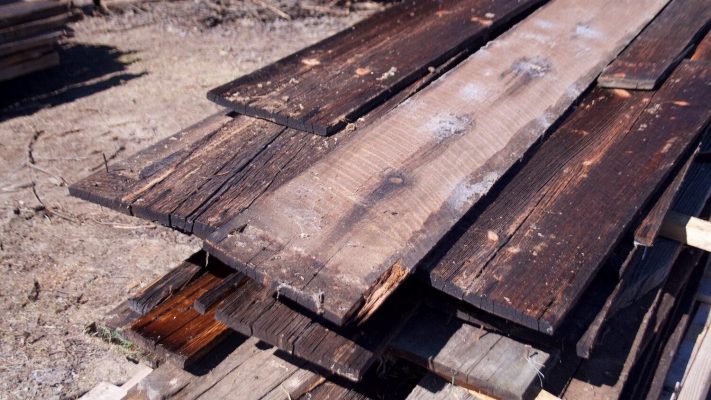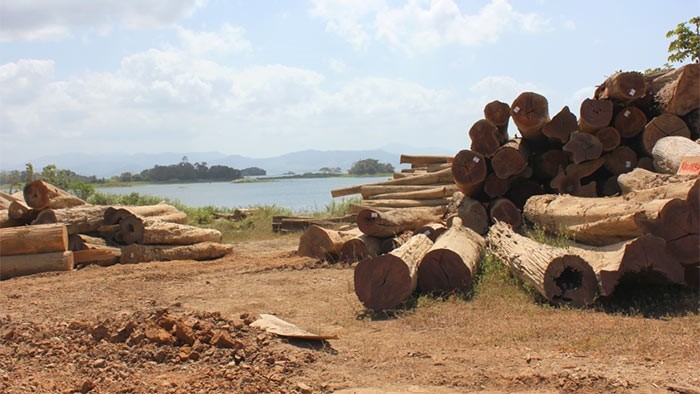Reclaimed wood is a wonderful design option that’s lauded for its eco-friendly nature. It’s a popular green building material for a good number of reasons. It resolves many factors on a designer’s checklist but for some the question of availability is a concern- will there be enough for my project? Will it ever run out? In this article, I’ll take a look at how reclaimed wood is both created and sourced in order to answer those questions.
Where Reclaimed Wood Comes From
First, an understanding of what constitutes reclaimed wood will be helpful. Often, reclaimed wood is sourced from old structures. Vintage buildings such as factories, houses and barns are what usually comes to mind but fencing, gymnasium bleachers, bowling alley floors and bridges are also common sources of post-consumer reclaimed wood. These sources are post-consumer meaning they have been utilized for some time for a specified purpose by people, and are now at a stage where they are being removed or replaced. Other times, the wood is obtained from sources in which the wood would go to a landfill, a wood chipper or be burned. Reclaimed wood is a means of salvaging wood for a higher purpose, keeping valuable resources out of landfills and utilizing resources to offset the need to cut down new trees.
There are five major sources we can seek for reclaiming wood post-consumer, post-industrial, water reclamation, orchard salvage, and forest floor salvage.

Why Reclaimed Wood Isn’t Going Anywhere
Many people think that all reclaimed wood is decades or even centuries old, and this is largely why reclaimed wood might seem like a limited resource. While much reclaimed wood is old wood, some reclaimed wood is not. Many reclaimed wood sourcing methods are sustainable as in enduring and continual, which means reclaiming wood will remain as a valuable and lasting process. It has to do with the various sourcing methods.
As already mentioned, there is post-consumer reclaimed wood, which occurs when wood is reclaimed from sources where consumers have used the wood and that purpose of use is no longer viable. This reclaimed wood is often older since the buildings it’s sourced from are vintage and sometimes dilapidated. Some post-consumer wood results from processes that aren’t readily known. For example, shipping dunnage or wood that is used to hold cargo in place on rail and ocean voyages is also a post-consumer souce. As long as goods are transported, shipping dunnage will be needed. Often, the wood from post-consumer reclaim shows signs of aging, weathering, and use, giving the wood the trademark rustic or barn wood appearance and character like nail and bolt holes that’s commonly associated with reclaimed wood.
This sourcing method will continue as long as there are structures slated for demolition and other sources like dunnage from which to reclaim the wood. Wood is still one of the most widely used building materials, so this method will continue to be practical. The reclaimed wood used today can be reclaimed and repurposed again. Longevity should be a factor in the material choice decision but at some point the wood chosen today can be reclaimed well into the future.
Another sourcing method that is on-going is post-industrial reclaimed wood. This is the result of scrap wood that is generated when wood products are created. For example, when furniture or items like wooden cutting boards are manufactured, there’s excess wood that ends up in a scrap pile. We reclaim it, diverting it from the landfill and giving it a new lease on life. This wood is salvaged new wood that is deemed as garbage. The resulting end-product can provide a very clean (for example, no nail holes) or eclectic aesthetic.
Water reclamation is another relatively untapped source for reclaiming wood that is of very high value. With this method, wood is reclaimed from flooded reservoirs that were created decades ago for purposes of flood control, irrigation, drinking water and to generate hydroelectric power. There are standing trees that have been underwater for decades. The wood is still good and with processes now available to retrieve the wood, it is an ethical method to source tropical hardwoods that will not negatively impact the rainforest.

Orchard salvage isn’t often discussed, but it produces some hardy and beautiful woods. When old orchard trees are no longer producing they are replaced. The culled trees are either relegated to firewood or worse yet, landfilled.
Finally, there’s forest floor salvage. This happens when trees are left behind as the result of timber cutting. Most companies leave behind smaller timber. Large volumes of wood left after a timber-cut delay regrowth, create fire hazards and can degrade water quality. Sometimes, this rejected wood is hauled away and turned into mulch. We believe it’s much better to reclaim this wood to allow it to meet its full potential. This is another method that will continue to be in use as long as the new wood is being cut down.
The Lasting Nature of Reclaimed Wood
Because wood can be reclaimed from so many sources, reclaimed wood will continue to be available as time goes on. These various sourcing methods provide variety of species and aesthetics to meet the many qualifying factors and demands of any design project. Quantity and quality are items not sacrificed when deciding whether or not to select reclaimed wood. We hope you see the upside to choosing reclaimed wood for your next project and will give it a look.
